With these expert help gardening tips, you’ll be well on your way to growing your best garden yet, whether you’re a seasoned pro or just starting out. Gardening can be a fulfilling hobby that not only provides you with fresh produce and beautiful flowers but also connects you with nature and improves your mental and physical well-being.
To help you get started on your gardening journey, we’ve compiled some of the best tips from gardening experts. From choosing the right plants to observing your garden’s conditions and seeking professional help, these tips will set you on the path to gardening success.
Key Takeaways:
- Buy a pot, potting soil, and get started with gardening.
- Learn about the vegetables you choose and take notes on their specific needs.
- Seek help from nurseries, extension services, or master gardeners when needed.
- Observe and learn from gardens in your neighborhood.
- Pay attention to soil composition, moisture levels, and plant labels.
- Don’t be discouraged by shade or problems; adapt and learn from them.
- Focus on completing one manageable task at a time and embrace imperfection.
Getting Started: Buying a Pot and Potting Soil
If you’re new to gardening, the first step is to invest in a pot and potting soil. Experts suggest starting small by buying a pot and potting soil and then deciding what to plant in it later. As a beginner gardener, it’s important to understand that gardening is a learning process and mistakes are bound to happen.
To ensure proper drainage in pots, make sure to create drainage holes or use pots with pre-existing holes. Improper drainage can lead to waterlogging and eventually kill your plants. It’s also important to water plants adequately and be attentive to signs of under or overwatering.
Before choosing what to plant in your pot, educate yourself on the vegetables you choose and their specific needs. Take notes and learn from your mistakes and successes each season. Seek help from resources such as nurseries, extension services, or master gardeners.
Consider the conditions and soil in your area before choosing plants. Look at the gardens around your neighborhood to see what grows well. Pay attention to the aspect and light requirements of plants. Embrace the power of repetition and plant plants in groups of three for a more impactful garden. Use the information on seed packets and plant labels to choose plants that will thrive in your garden conditions. Be mindful of shade and consider growing plants like herbs and strawberries that do well in it.
Remember, gardening is a process and it’s important to focus on completing one task at a time. Learn from your mistakes and let nature take its course. Enjoy the process of gardening and soon you’ll have a thriving garden to call your own.
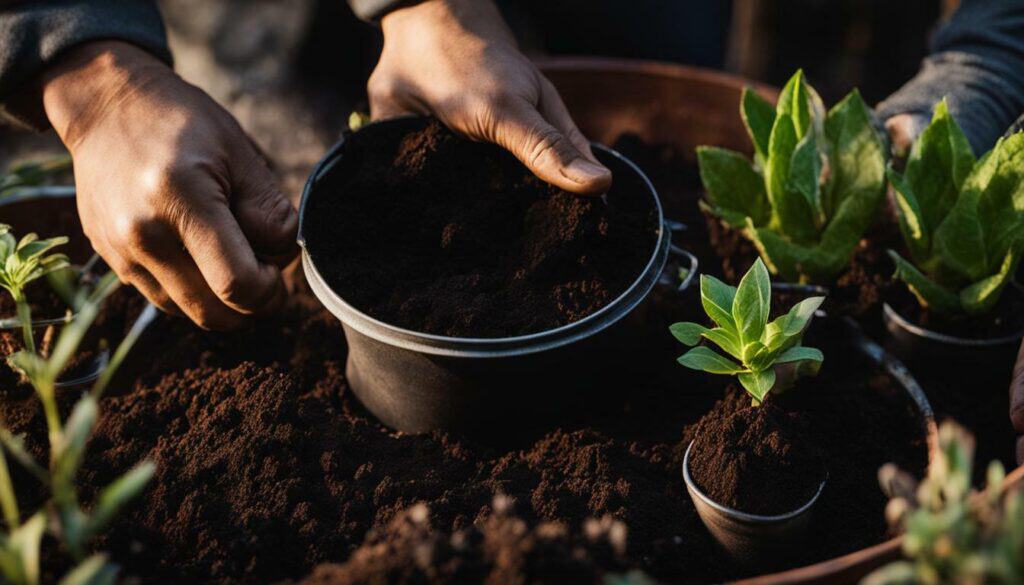
Educate Yourself: Know Your Veggies and Their Needs
Before you start planting, educate yourself about the specific needs of the vegetables you want to grow. Buying a pot and potting soil is a great way to get started with beginner gardening. However, to ensure success, it’s essential to study the specific requirements of each vegetable you choose to grow.
Understanding the amount of sunlight, water, and nutrients your plants need is crucial to their growth and longevity. Take notes each season to learn from your mistakes and successes. Gardening is a continuous learning process, and it’s essential to embrace it to become a better gardener.
Don’t be afraid to seek advice from resources such as nurseries and gardening experts. They can provide invaluable gardening advice to help you grow your best garden yet.
| Tip | Explanation |
|---|---|
| Study Your Soil | Getting your soil tested will help you understand its composition and moisture level, making it easier to maintain a healthy garden. |
| Consider Sunlight | Understanding the direction your garden faces and how it affects sunlight and plant growth can make a big difference in the success of your garden. |
| Plant in Groups of Three | By planting a handful of great plants and repeating them throughout your garden, you can create visual impact and make maintenance easier. |
| Read Seed Packets | Always read the labels on seed packets to ensure you choose plants that suit your garden conditions. |
| Embrace Shade | Don’t let shady spots discourage you. There are many plants that can thrive in shady areas, such as ferns and hostas. |
Remember, certain vegetables like strawberries and greens are easy to grow and provide quick gratification. Observe and learn from your plants, watering them appropriately and ensuring good drainage. Enjoy the process of gardening by focusing on one task at a time and learning from your experiences. Don’t strive for perfection, as the garden is always evolving.
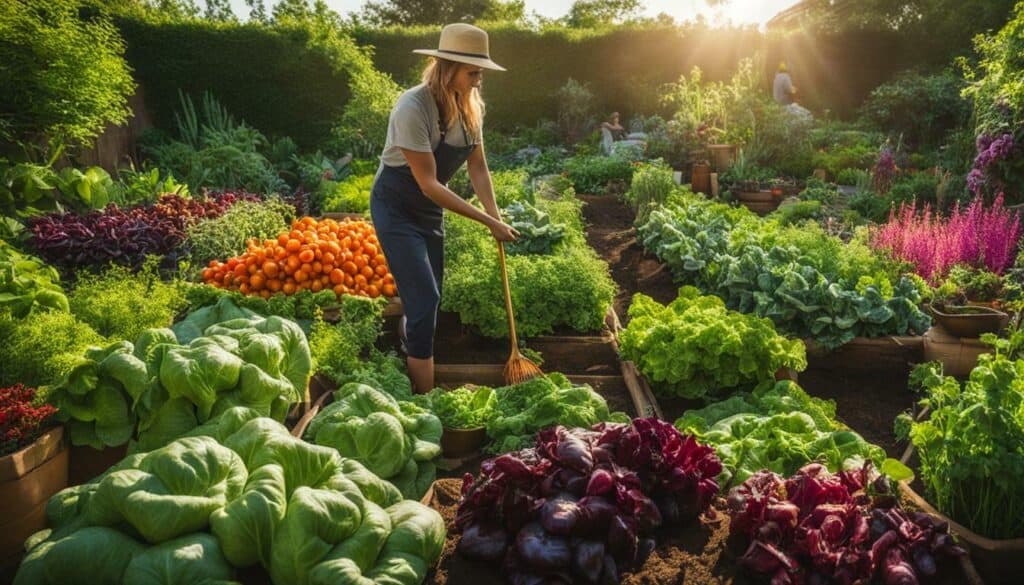
Learning from Experience: Taking Notes and Reflecting
One of the best ways to improve your gardening skills is to take notes and reflect on your experiences. Starting with the basics of buying a pot and potting soil, it’s essential to educate yourself on the specific needs of different plants. Keeping a journal to track successes and mistakes can help you determine what to plant in future seasons and guide your garden maintenance decisions.
Seeking gardening advice from resources such as nurseries, extension services, and master gardeners can also be valuable. Observing gardens in your neighborhood can provide insights into what will grow well in your own garden. In addition, understanding the conditions and soil composition is important. Soil testing can guide plant selection and help ensure optimal growth.
Knowing the direction your garden faces and the amount of sunlight it receives is crucial for choosing the right plants. It’s recommended to embrace the power of grouping plants in threes for a more impactful design. Reading labels on seed packets and seedlings is essential, as plants have specific sun and temperature requirements. Proper watering techniques, including providing adequate drainage, are crucial for plant health.
Deadheading, or removing spent flowers, encourages more blooms, but some plants should not be deadheaded if they are grown for decorative fruits or pods. Paying attention to the amount of light different plants need is essential, and most vegetables require at least 8 hours of direct sunlight per day.
Controlling weeds through hand-weeding and hoeing is recommended, and mulch can help prevent weed growth. Dividing perennial plants can help rejuvenate them, and dividing is best done in early spring or fall. It’s important to water plants deeply, rather than lightly each day, to encourage root growth. Leaving some fallen leaves in the garden can provide beauty and food for birds.
Soil quality is more important than fertilizer, and organic amendments such as compost and well-aged manure are recommended. Late summer or early autumn is the best time to divide and transplant spring-blooming perennials. Rhubarb flower stalks should be removed to focus on foliage production.
When transplanting container-grown perennials, filling the hole with the same soil is better than using bagged soil. Mounding potato plants deep and storing harvested potatoes in complete darkness is advised. Providing 1 to 2 inches of water per week for garden plants is important, especially if there is not sufficient rainfall. Cleaning up fallen branches and debris is recommended, but compacting wet soil should be avoided. Pruning some perennials in spring, rather than fall, is necessary for their survival.
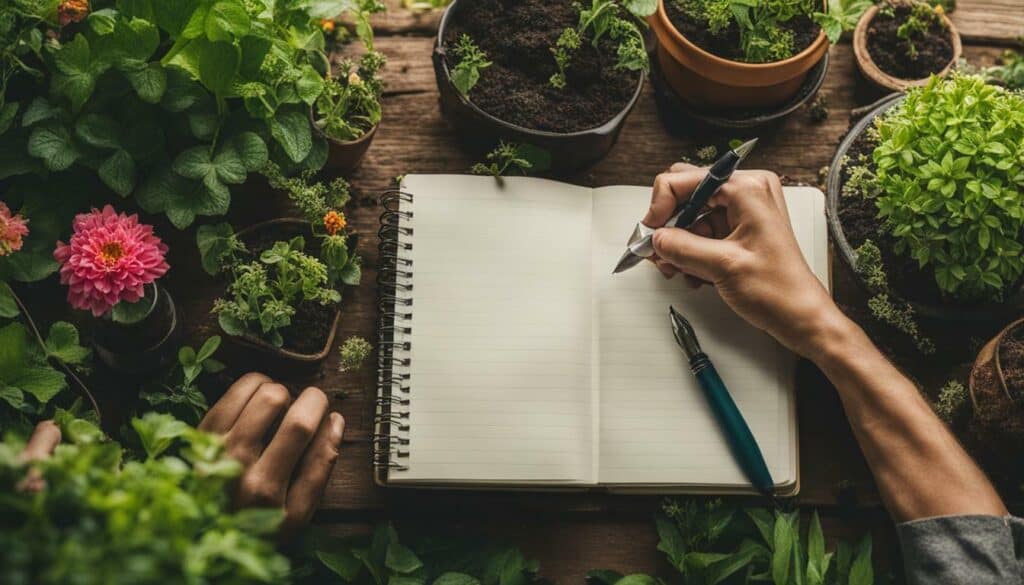
Seeking Help: Nurseries, Extension Services, and Master Gardeners
When you need guidance or have specific gardening questions, don’t hesitate to reach out to nurseries, extension services, or master gardeners – they can be valuable resources for any gardener. Whether you’re just starting or have years of experience, it’s always a good idea to take advantage of the expert advice and assistance they can offer.
Nurseries are a great place to start, with their knowledgeable staff who can offer advice on choosing plants and provide information on soil testing. They can help you understand the growing requirements of different plants and offer tips on how to care for them.
| Nurseries | Location | Phone |
|---|---|---|
| Nature’s Best Nursery | 123 Main St. | (555) 555-5555 |
| Green Thumb Garden Center | 456 Elm Ave. | (555) 555-5555 |
Extension services and master gardeners are also great options for seeking help, as they can provide expert advice tailored to specific regions and offer valuable resources and programs. They can help you understand the climate, soil conditions, and pests unique to your area, and offer tips on how to deal with them. They can also provide information on organic gardening, composting, and other sustainable practices.
Here are some useful contacts for extension services and master gardeners:
- U.S. Department of Agriculture Cooperative Extension
- Master Gardeners Program at the University of California
- Cornell Cooperative Extension
It is important to utilize these resources and ask questions to learn and improve your gardening skills. Gardening can be a challenging and enjoyable hobby, and seeking help from these sources can contribute to a successful and rewarding experience.
Additionally, reading gardening guides and taking notes on what works and what doesn’t can be helpful for future gardening endeavors. Keeping a gardening journal can help you track your successes and failures and learn from them.
Remember, seeking help is not a sign of weakness, but rather a smart and proactive approach to gardening. Don’t be afraid to ask for advice and guidance – it can make all the difference in growing a beautiful and healthy garden.
Local Inspiration: Observing Gardens in Your Neighborhood
Take a walk around your neighborhood and observe the gardens to get ideas and insights for your own outdoor gardening. You might discover that certain plants thrive in your area and pick up tips on how to care for them. Notice which plants grow well in shady areas and how they’re arranged to create an aesthetically pleasing space.
Observing the gardens in your local area is an excellent way to get inspired and learn what works best in your climate. Consider the layout and theme of the gardens you visit, and think about how you can apply similar concepts to your own garden. Take note of any plants that catch your eye and look them up online to see if they would be a suitable addition to your own garden.
By observing the gardens in your neighborhood, you can also gain insight into the care and maintenance required to keep plants thriving. Notice which plants are pruned and deadheaded, and how often this is done. Look for signs of pests and disease and how they’re being addressed.
Don’t be afraid to strike up a conversation with other gardeners in your community. Ask them about their favorite plants or how they’ve dealt with common gardening challenges. You might even find a mentor who’s willing to offer gardening advice and tips.
Overall, observing gardens in your neighborhood can be a great source of inspiration and education for your own outdoor gardening journey. By taking the time to notice and appreciate the beauty around you, you can create a thriving and beautiful garden that brings joy to both you and your community.
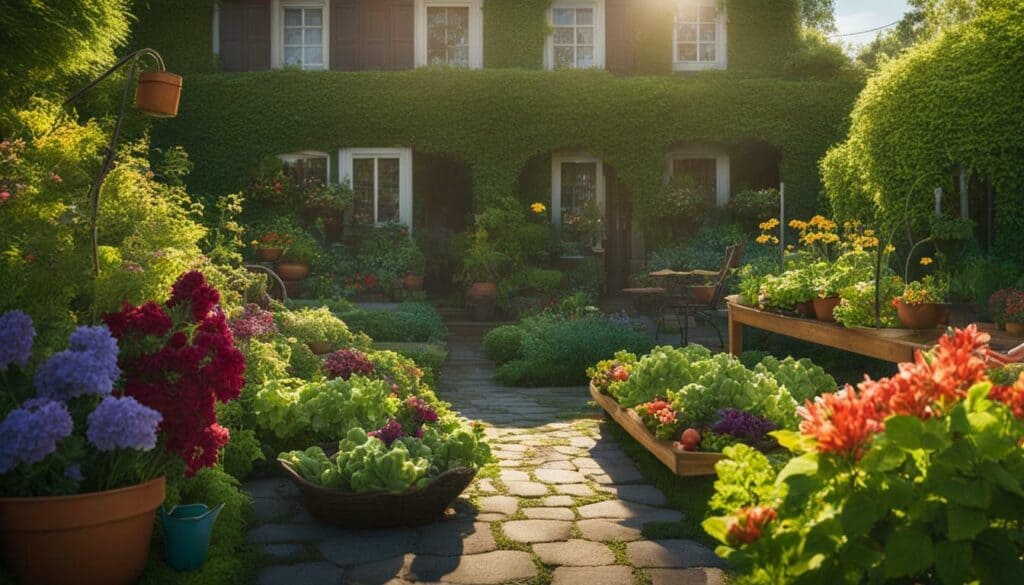
Knowing Your Garden Conditions: Soil Composition and Moisture
To create the optimal conditions for your plants, it’s crucial to know the composition and moisture levels of your garden soil. This information will help you select the appropriate plants, adjust the soil pH if necessary, and determine the right amount of water to use.
Organic gardening is all about improving the natural soil structure using compost, manure, and other organic matter. When preparing your soil, aim for a sandy loam soil texture, which is optimal for most plants. Sandy soil drains quickly but may require more frequent watering, while clay-rich soil retains moisture but may require more frequent soil aeration to avoid waterlogging. Testing your soil will help you determine the appropriate soil amendments to improve its structure and pH levels.
| Soil Type | Characteristics |
|---|---|
| Sandy soil | Drains quickly, low in nutrients, requires more frequent watering |
| Clay-rich soil | Retains moisture, high in nutrients, may require more frequent aeration |
| Silty soil | Smooth texture, retains moisture and nutrients, prone to compaction |
| Loamy soil | Optimal soil texture, easy to work with, retains moisture and nutrients |
Some plants, such as succulents and cacti, prefer well-draining soil, while others, such as ferns and hostas, prefer moist soil. Understanding the moisture needs of your plants will help you determine the right amount of watering and avoid overwatering or underwatering.
Organic gardening requires more attention to soil maintenance, but it’s worth it for the healthier and more sustainable plants it produces. Make sure to add compost, manure, or other organic matter to your soil regularly to replenish its nutrients and improve its structure. Fertilizers should also be used sparingly and only when necessary.
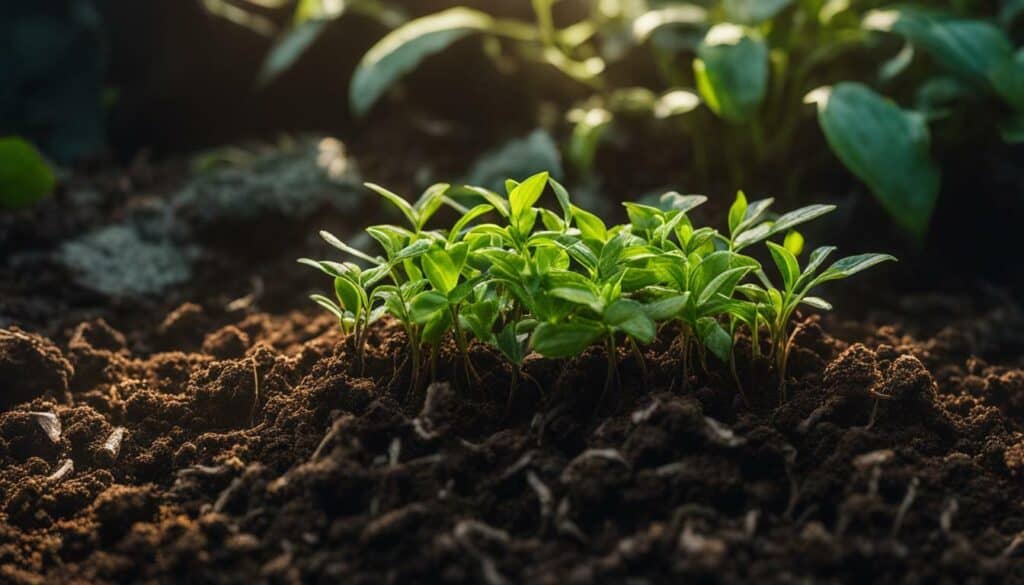
Knowing your garden conditions, specifically the soil composition and moisture, is essential for successful gardening. Taking care of your plants involves not only watering and fertilizing but also proper drainage, pruning, and division. Remember to focus on one task at a time and embrace the imperfections of your garden. Learn from experience, seek advice when needed, and enjoy the process of growing your own plants.
Considering Light and Direction: Optimizing Plant Growth
When planning your garden, take into consideration the direction it faces and the amount of light it receives throughout the day. This will determine which types of plants will thrive in your garden. Here are some tips to help optimize plant growth:
- Know your garden’s aspect, which is the direction it faces. This affects the amount of sunlight the garden receives and what plants will thrive there.
- Seek out help from resources such as nurseries, extension services, or master gardeners. They can provide valuable advice on plant selection and care.
- Take notes and track your gardening progress. Learn from your successes and failures to improve your gardening skills over time.
- Test your soil to understand its composition and characteristics. This will help you determine what plants are suitable for your garden.
- Embrace the power of repetition. Planting a few types of plants in groups of three can create visual impact and simplify maintenance.
- Pay attention to the labels on seed packets and seedlings. Plant species have specific light and temperature requirements, so choose plants that are compatible with your garden’s conditions.
- Don’t be discouraged by shade. While tomatoes may not grow well in shady areas, there are many other plants that thrive in low light conditions, such as herbs and strawberries.
- Water your plants properly. Avoid overwatering by under-watering and letting plants signal when they need water. This prevents root rot and promotes healthy plant growth.
- Focus on completing one manageable task at a time instead of getting overwhelmed by the whole garden. This allows for better attention to detail and more successful outcomes.
- Remember that gardening is a continuous learning process. Don’t be afraid to make mistakes and experiment. Nature is ever-changing, and your garden will evolve over time.
By considering light and direction and implementing these tips, you can optimize plant growth and create a thriving garden.
Maximizing Impact: Repeating Great Plants throughout the Garden
To create a visually cohesive garden, choose a few standout plants and repeat them throughout different areas of your outdoor space. This creates a sense of harmony and allows the eye to flow throughout the garden. It’s a technique used by professional designers to create stunning gardens, but it’s also easy to do for beginner gardeners.
Begin by selecting a few plants that you really love, or that are well-suited to your garden’s conditions. Look for plants that bloom at different times of the year so that you have color throughout the seasons. Some good options might include lilies, hydrangeas, or roses. You could also choose a particular color scheme and select plants that fit within that palette.
Once you’ve chosen your plants, repeat them in different areas of your garden. For example, if you’ve chosen lilies, plant them in a few different beds or containers throughout the space. This repetition creates a sense of unity and helps to tie everything together.
Another benefit of repeating plants is that it can be easier to care for them. Once you’ve figured out the ideal growing conditions for a particular plant, you can apply that knowledge to all of the specimens in your garden. For example, if you know that your lilies prefer well-draining soil and partial shade, you can ensure that all of your lilies are planted in similar conditions.
Finally, don’t be afraid to mix things up a bit. You can repeat plants in different sizes, colors, or varieties to add interest and texture to your garden. For example, you might repeat lilies, but choose different colors or varieties to create visual interest.

Repeating great plants throughout your garden is a simple yet effective way to maximize visual impact. It creates a sense of unity and harmony while also making it easier to care for your plants. So next time you’re planning your garden, consider selecting a few standout plants to repeat throughout the space.
Choosing the Right Plants: Labels and Climate Considerations
When choosing plants for your garden, pay attention to the information on the labels and consider the climate you live in. This is especially important for beginner gardeners who are still learning the ropes.
Make sure you choose plants that are suitable for your specific climate and growing conditions. If a plant requires full sun and you have a shady area, it’s best to choose something else. The same goes for plants that need a lot of water if you live in a dry area.
The labels on seed packets and seedlings will usually tell you what you need to know about the plant’s growing requirements. Look for information on the amount of sunlight the plant needs, how much water it requires, and what kind of soil it prefers.
When it comes to sunlight, consider the aspect of your garden and the direction it faces. This will determine the amount of light your plants will receive and what will grow well there. If you have a north-facing garden with lots of shade, don’t be discouraged! There are still many herbs and other plants that can thrive in these conditions.
Understanding the soil conditions in your garden is also crucial. Consider getting your soil tested to determine its composition and moisture levels. This will give you a better idea of what types of plants will grow well in your garden.
Finally, don’t forget to consult local resources like nurseries, extension services, and master gardeners for advice and guidance. These experts can help you make informed decisions about what to plant and how to care for your garden.
Remember, choosing the right plants for your garden is key to a successful and bountiful harvest. By paying attention to labels and climate considerations, you’ll be well on your way to creating a thriving garden that you can enjoy for years to come.
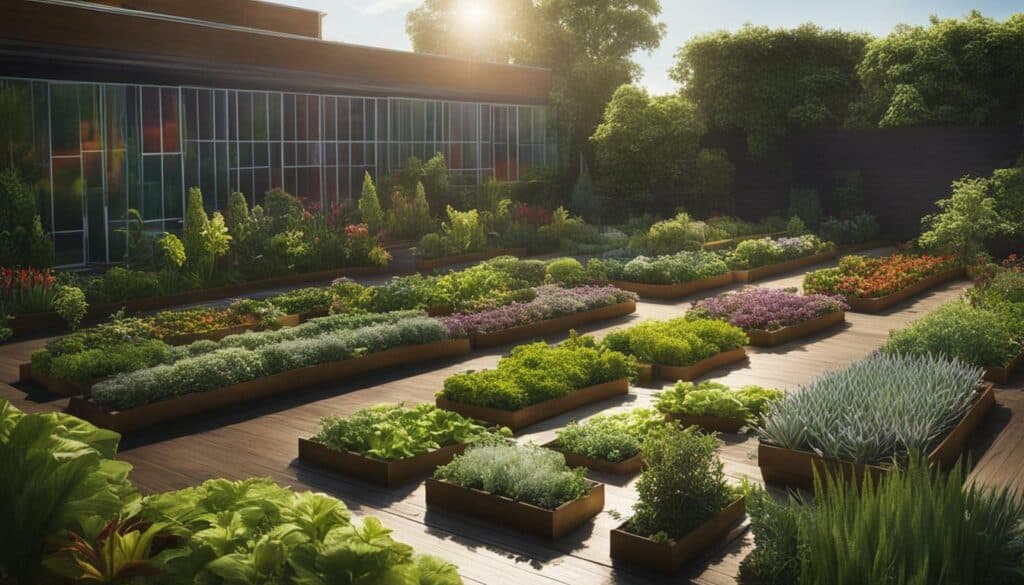
Embracing Shade: Suitable Plants for Shady Areas
Don’t let shade limit your gardening possibilities – embrace it and choose plants that do well in shady areas. When starting a garden in a shady area, it’s important to educate yourself on the needs of the plants you choose, as different plants require different amounts of sunlight. Seek help from resources like local nurseries or extension services, and observe the gardens in your neighborhood to see what grows well in similar conditions.
But don’t be discouraged by the shade! There are plenty of plants that thrive in shady areas. For example, runner beans and herbs are great options for a shady garden. You can also try growing California poppies for their vibrant orange color or strawberries in pots.
When it comes to keeping your garden alive, make sure to provide proper drainage for your plants and avoid over-watering. Embrace the imperfections of your garden and focus on what works well rather than what doesn’t.
Remember, gardening is a process of trial and error. Take on manageable tasks, learn from your mistakes, and appreciate the ever-changing nature of your garden. With these tips, your shady garden will be thriving in no time!
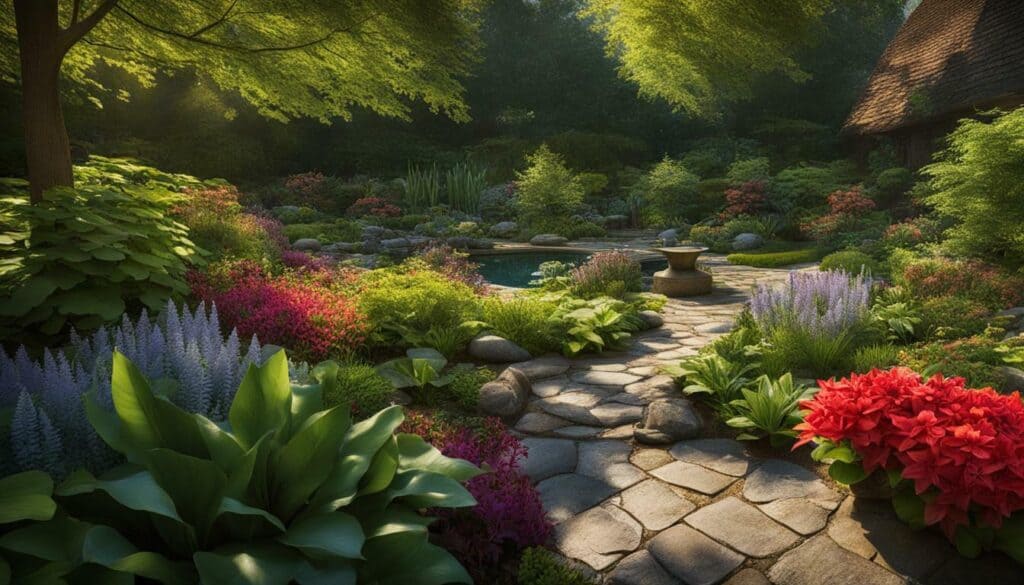
Gardening in Urban Environments: Overcoming Challenges
If you live in an urban environment, don’t let the challenges discourage you – the fundamentals of gardening still apply. With the following tips and advice from gardening experts, you can overcome the unique challenges of urban gardening and create a thriving garden.
First, start with the basics. Purchase a pot and potting soil to get started, and educate yourself on the specific needs of the plants you choose to grow. Keep a journal to track your progress, and seek help from resources like local nurseries, extension services, or master gardeners.
Look at the gardens in your neighborhood to see what grows well in similar conditions. Get your soil tested to understand its composition and make appropriate planting choices. Consider the direction your garden faces to determine which plants will thrive, and embrace the power of repeating a handful of plant varieties throughout your garden for impact.
Don’t be discouraged by shade; many plants, like herbs and runner beans, can thrive with less sun. Know the optimal growing conditions and requirements for specific plants you want to grow. Make sure pots have proper drainage holes to prevent waterlogging, and remember that under-watering is better than over-watering; plants will visibly show when they need water.
Focus on completing one task at a time to avoid feeling overwhelmed in the garden, and accept that mistakes will happen, and learn from them for future gardening endeavors. Understand that nature is ever-changing, and your garden will never be perfect.
Know your USDA Hardiness Zone to choose plants that can survive the winter in your area. Use composted, rotted manure in your soil, and avoid using fresh manure that may contain pathogens or parasites. Perennials take time to mature, so be patient and allow them to reach their full size. Start seeds indoors to get a head start on the growing season.
Layout your vegetable garden in advance and consider crop rotation and companion planting. Deadhead spent flowers to encourage more blooms and stronger plant growth. Learn the light requirements of different plants and provide suitable conditions for optimal growth. Control weeds through hand-weeding and hoeing, and use mulch to smother annual weeds.
Divide hostas in spring or fall to rejuvenate the plants or increase their numbers. Provide appropriate support and sun exposure for specific plants like panicle hydrangeas. Leave certain plant foliage and seed heads in the garden for their beauty and to feed birds. Pay attention to the optimal temperature for ripening tomatoes and bring them indoors if necessary.
Plant spring-blooming bulbs in the fall at the appropriate depth and consider their perennials. Use fertilizers sparingly and focus on improving soil quality with organic amendments. Late summer or early autumn is the best time to divide and transplant perennials. Remove flower stalks from rhubarb to promote foliage growth.
Transplant container-grown perennials at the same depth and use the same soil as in the container. Mound potatoes deep in the soil and keep them in darkness to prevent green skin. Water plants deeply once a week rather than lightly every day to encourage deeper root growth. Use fall leaves as compost ingredients rather than discarding them.
Plan your garden before creating planting beds and consider aspects like sunlight, spacing, and soil conditions. Clean up fallen branches and debris in your garden when the soil is no longer wet. Cut back perennials that don’t fare well in winter in the spring. Prune certain plants in spring to ensure their winter protection and survival.
These tips cover a range of challenges faced in urban gardening, such as space limitations, limited sunlight, soil quality, and plant selection. By being informed and proactive, it is possible to overcome these challenges and enjoy a successful garden in urban environments.
Conclusion
By following these expert help gardening tips, you’ll be well on your way to growing a thriving and beautiful garden right in your own backyard. Whether you’re a seasoned gardener or just starting out, remember to educate yourself on the needs of each plant and keep track of your progress in a journal. Seek help from resources such as nurseries and extension services, and make adjustments to your soil and garden conditions as needed. Grouping plants together for maximum impact and choosing the right plants for your climate and environment are also key. Don’t be discouraged by shade or setbacks; focus on one manageable task at a time and enjoy the process of growing a garden. With these tips in mind, your garden will flourish and bring you joy for years to come.
FAQ
Q: How do I get started with gardening?
A: Just start by buying a pot and potting soil. It’s a simple way to begin your gardening journey.
Q: How can I educate myself about the vegetables I want to grow?
A: Take the time to learn about the specific needs of each vegetable. Research online or consult gardening books for information.
Q: What should I do with my gardening mistakes and successes?
A: Take notes and learn from them. Reflection is an important part of the gardening process.
Q: Where can I seek help for my gardening queries?
A: Resources like nurseries, extension services, or master gardeners can provide expert guidance and advice.
Q: How can I know what plants will grow well in my area?
A: Observe the gardens in your neighborhood to see which plants thrive in your local climate and conditions.
Q: How can I understand the conditions of my garden?
A: Test your soil for its composition and moisture. This will help you make informed decisions about your plants’ needs.
Q: What factors should I consider for optimal plant growth?
A: Consider the direction your garden faces and the amount of light it receives. These factors can impact plant growth.
Q: How can I create impact in my garden?
A: Plant a handful of great plants and repeat them throughout your garden. This will create visual impact.
Q: How do I choose the right plants for my garden?
A: Read labels and consider your climate. Choose plants that are suitable for your specific conditions.
Q: Can I garden in shady areas?
A: Yes, you can. Embrace shade by choosing plants like herbs and runner beans that thrive in shady conditions.
Q: Is gardening in an urban environment challenging?
A: While there may be unique challenges, the basics of gardening remain the same in urban environments.
Q: How can I ensure proper drainage for potted plants?
A: Create drainage holes in your pots to provide proper drainage for your potted plants.
Q: Is it better to over-water or under-water my plants?
A: Under-watering is preferable to over-watering. Water plants appropriately to avoid waterlogging.
Q: Should I try to do everything in my garden at once?
A: Focus on completing one manageable task at a time rather than trying to do everything at once.
Q: Will my garden ever be perfect?
A: Accept that your garden will never be perfect, but focus on the things that work well.
Q: How do I choose the right plants for my climate?
A: Know your USDA Hardiness Zone to choose plants that are suitable for your climate.
Q: When should I prune spring-flowering shrubs?
A: Prune them after their blooms fade to preserve next year’s flower buds.
Q: What type of manure should I use for soil amendment?
A: Use composted, rotted manure for soil amendment. Avoid fresh manure or potentially harmful animal manure.
Q: How long does it take for perennials to reach their mature size?
A: Perennials take time to reach their mature size. Be patient and allow them to grow.
Q: Should I start seeds indoors?
A: Starting seeds indoors can give you a head start on the growing season.
Q: How much sunlight do vegetables need?
A: Most vegetables require at least 8 hours of direct sunlight per day for optimal growth.
Q: How can I control weeds in my garden?
A: Control weeds through hand-weeding and hoeing. Avoid deep cultivation that can disturb plant roots.
Q: When should I divide hostas?
A: Divide hostas in spring or fall to rejuvenate and propagate the plants.
Q: Do all hydrangea varieties require sunlight for optimal flowering?
A: No, some hydrangea varieties require sun for optimal flowering, while others can tolerate shade.
Q: Should I leave ornamental grasses and perennials during winter?
A: Yes, leaving ornamental grasses and perennials can provide winter beauty and food for birds.
Q: Should I bring tomatoes inside if the temperature gets too cold?
A: If the temperature drops below the optimal range for ripening tomatoes, consider bringing them inside to continue their growth.
Q: When should I plant spring-blooming bulbs?
A: Plant spring-blooming bulbs in the fall for beautiful blooms the following year. Deadhead spent flowers for better bulbs next year.
Q: Should I focus on soil quality or rely on fertilizers?
A: Focus on soil quality by incorporating organic matter. This will benefit your plants more than relying solely on fertilizers.
Q: When should I divide and transplant spring-blooming perennials?
A: Divide and transplant spring-blooming perennials in late summer or early autumn to give them time to establish before winter.
Q: Should I remove flower stalks from rhubarb?
A: Yes, removing flower stalks from rhubarb can increase foliage production and overall plant health.
Q: How should I transplant container-grown perennials?
A: Transplant container-grown perennials at the same depth as they were in the container to ensure successful establishment.
Q: How should I store harvested potatoes?
A: Store harvested potatoes in complete darkness to prevent them from turning green, which indicates solanine toxicity.
Q: How often should I water my garden plants?
A: Water garden plants deeply once a week rather than lightly each day. Deep watering promotes deeper root growth.
Q: What can I do with fall leaves?
A: Instead of discarding them, use fall leaves as compost ingredients to improve soil fertility and structure.
Q: When should I start planning for my spring and summer gardens?
A: Start planning well in advance to ensure you have the right plants, tools, and knowledge for a successful garden.
Q: How do I start a garden?
A: Consider aspects such as sunlight, soil quality, and proper planting bed preparation when starting a garden.
Q: When should I clean up my garden?
A: Clean up your garden in early spring, but wait for the soil to dry out before walking on it to avoid compacting it.
Q: Should I cut back certain perennials in spring or fall?
A: Cut back certain perennials in spring to allow for new growth. Avoid cutting them back in fall, as they benefit from the protection of their foliage during winter.
What Are Some Expert Tips for Growing a Successful Vegetable Garden?
When it comes to nurturing a fruitful vegetable garden, there are some tried and tested expert tips for vegetable garden that can work wonders. Firstly, choose the right location with plenty of sunlight. Proper soil preparation, including composting, is crucial for healthy plant growth. Regular watering, opting for organic pest control methods, and pruning as needed contribute to successful yields. Lastly, maintaining a consistent gardening schedule and keeping track of plant rotation can enhance long-term productivity.
Source Links
- https://food52.com/blog/16423-23-tips-from-the-experts-for-making-your-garden-grow
- https://www.thespruce.com/get-your-garden-ready-7112233
- https://www.bhg.com/gardening/yard/garden-care/gardening-tips-for-every-gardener/
- https://www.architecturaldigest.com/story/gardening-tips
- https://www.readersdigest.ca/home-garden/gardening/19-basic-gardening-tips-save-time-and-money/
- https://www.gardendesign.com/how-to/potting-soil.html
- https://getbusygardening.com/potting-soil-for-container-gardening/
- https://www.almanac.com/content/container-gardening-vegetables
- https://extension.wvu.edu/lawn-gardening-pests/gardening/gardening-101/vegetable-gardening-for-beginners
- https://miniurbanfarm.com/gardening-goals/
- https://oursimplehomestead.com/starting-a-vegetable-garden-for-beginners/
- https://www.honestlymodern.com/become-a-better-gardener-by-taking-notes/
- https://www.newlifeonahomestead.com/lessons-learned-from-my-first-garden/
- https://tualatinlife.com/people/learning-from-the-garden-a-lifetime-reflection/
- https://www.uvm.edu/extension/mastergardener/gardening-resources
- https://extension.oregonstate.edu/mg/get-your-gardening-questions-answered
- https://extension.oregonstate.edu/mg/about-master-gardener-program
- https://www.robingreenfield.org/grow/
- https://www.bhg.com/gardening/yard/garden-care/ten-steps-to-beginning-a-garden/
- https://www.epicgardening.com/20-inspiring-gardening-documentaries/
- https://www.gardendesign.com/soil/
- https://learn.eartheasy.com/articles/know-your-garden-soil-how-to-make-the-most-of-your-soil-type/
- https://www.growveg.com/guides/understanding-soil-types-for-vegetable-gardens/
- https://aggie-horticulture.tamu.edu/ornamental/a-reference-guide-to-plant-care-handling-and-merchandising/light-temperature-and-humidity/
- https://www.canr.msu.edu/news/choosing_a_smart_site_for_your_vegetable_garden
- https://extension.oregonstate.edu/gardening/techniques/environmental-factors-affecting-plant-growth
- https://www.yellowbirchhobbyfarm.com/maximize-your-garden-space-with-permaculture/
- https://content.ces.ncsu.edu/extension-gardener-handbook/16-vegetable-gardening
- https://content.ces.ncsu.edu/extension-gardener-handbook/appendix-a-garden-journaling
- https://www.canr.msu.edu/resources/a_guide_for_the_selection_and_use_of_plants_in_the_landscape_e2941
- https://www.provenwinners.com/learn/right-plant-right-place
- https://extension.okstate.edu/fact-sheets/basic-plant-care-understanding-your-plants-needs.html
- https://extension.umn.edu/planting-and-growing-guides/gardening-shade
- https://www.southernliving.com/garden/plants/shade-loving-plants
- https://www.bhg.com/gardening/trees-shrubs-vines/shrubs/shrubs-for-shade/
- https://medium.com/@PlantedPerfection/overcoming-common-challenges-in-urban-gardening-tips-and-tricks-for-success-98620551b8e9
- https://storables.com/articles/what-is-urban-garden/
- https://www.epa.gov/sites/default/files/2014-03/documents/urban_gardening_fina_fact_sheet.pdf
- https://www.ncbi.nlm.nih.gov/pmc/articles/PMC5153451/
- https://www.ncbi.nlm.nih.gov/pmc/articles/PMC3661291/
- https://growingourown.wordpress.com/6-conclusion/






Leave a Reply